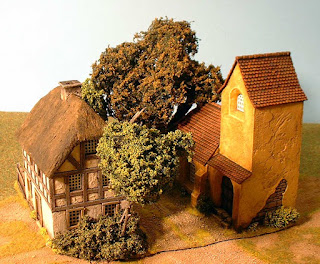In the mid-2000's I made some models for US wargamer Matt Pavone, who was keen to refight the Battle of Dresden, 1813. I did a lot of research and we had all kinds of plans to build the Gross Garten park, the old city walls, even the famous palaces and churches of that spectacular city! But in the end we only got as far as a series of four village units, which you see below. I also used one as the header photograph for my blog, as I thought it gave an instant idea of what it is about.
The design of each village unit in this case was to be a single piece with room for one of Matt's 16-figure infantry units to fit on the base. Within that, I wanted to make the layout of each unit different. These aren't Matt's figures you see here by the way, but those of my lifelong wargames accomplice Garry Broom, who has thousands of figures for this period and adds hundreds more every year. One day we'll even get round to having a game with them!
Anyway, these villages were based on proper research into the style of "vernacular" buildings in Saxony, rather than just being "generically German". In this area it was common for buildings to have their ground storey made of field stone, with the upper floor being timber-framed. As in many places the appearance of the churches depended at least as much on when they had been built as on any local style preference. This simple structure would have been built in the early Middle Ages, and could be almost anywhere in Germany, although the rather bright ochre colouring is common around these parts. Oddly, the fences weren't altogether generic. Wicker and vertical-plank fences exist across Germany, but the horizontal-plank version was most typical of Saxony and Brandenburg.












Another lovely looking batch of buildings John - but its a shame you didnt get to tackle some of the other structures mentioned in your intro!
ReplyDeleteThanks, rross, and you're right. I was looking forward to doing those! I got a book in German about the Gross Garten park and its buildings, and another one about the fortifications of the city, which were still partially in place at the time of the Napoleonic battle. What I really fancied though were the palaces and churches of "Florence on the Elbe" as the city was known. But I think Matt's circumstances changed, and I had a period of less time to make models.
ReplyDeleteJohn I have dreams of doing the battle in a smaller scale so I can place a Gross Garten and walls on the table. Do you recall the names of the books about the Garten and walls that you acquired? Thanks Richard
DeleteSorry, all my terrain books are packed away in boxes as I'm supposed to be decorating the living room. And before that happens, I've got to decorate most of the upstairs here at Boadle Towers. So I can't access them at present. Both books were in German of course. I think one was called maybe "Festung Dresden", the other something like "Der Grosser Garten, Dresden". You should be able to find them online if they are still in print (it was 15+ years ago I got them). If you have no luck with Google and are still keen, do come back and I will dig them out of the boxes.
DeleteThanks John. I’ll see how my googleing goes
DeleteA tidy-up today has brought these to books to light, and I remembered you had asked for the details. They are "Festung Dresden" by Eva Papke, pub Michel Sandstein Verlag 1997, and "Der Grosse Garten zu Dresden" by the Saechsische Schloesserverwalterung, also pub Michel Sandstein Verlag, in 2001. Hope this is of use, ret75001.
DeleteVery nice John and I really like the ochre colour on the building. All the models are brilliant BTW:).
ReplyDeleteFantastic - I love the bright ochre of these buildings - it also reminds the Games Workshop Studio Empire terrain for Warhammer in the 1990s had very bright yellow buildings - maybe deriving from similar inspiration.
ReplyDeleteWell spotted! GW's models, made by the wonderful Dave Andrews, were an inspiration to me at one stage. And they were inspired, as I was, by the actual use of naturally occurring pigments in colouring the surface of rendered buildings, going back to the Middle Ages at least. This was particularly common in towns, where you could credibly use soft pinks, blues and greens. But in rural areas this is a bright as I would want to get: yellow ochre then every shade of buff and beige as well as the natural white of lime-wash.
Delete